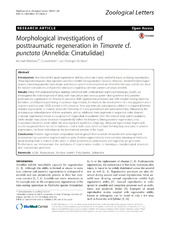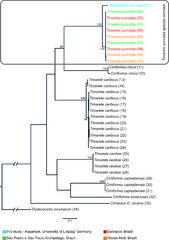| dc.description.abstract | Introduction: Annelids exhibit great regenerative abilities, which are mainly used after injury or during reproduction. These lophotrochozoans thus represent excellent models for regeneration research. However, detailed morphological studies concerning annelid musculature and nervous system redevelopment are limited to few taxa, and do not allow for broader comparisons and general conclusions regarding common patterns amongst annelids. Results: Using immunohistochemical staining combined with confocal laser scanning microscopy (cLSM), we investigated the redevelopment of body wall musculature and nervous system during anterior and posterior posttraumatic regeneration in Timarete cf. punctata. Both regeneration processes start with wound healing, blastema formation, and blastema patterning. In posterior regeneration, this leads to the development of a new pygidium and a segment addition zone (SAZ) anterior to this structure. New segments are subsequently added in a sequential fashion. Anterior regeneration in contrast shows the formation of a new prostomium and peristomium first, followed by the simultaneous redevelopment of three segments, and an additional three segments in sequential order. Anterior muscular regeneration shows an outgrowth of longitudinal musculature from the residual body wall musculature, while circular musculature develops independently within the blastema. During posterior regeneration, new musculature becomes visible when the new segments reached a certain age. Neuronal regeneration begins with neurite outgrowth from the old ventral nerve cord in both cases, which are later forming loop structures. In anterior regeneration, the brain redevelops at the anteriormost position of the loops. Conclusions: Posterior regeneration recapitulates normal growth from a certain timepoint with serial segment development by a posterior segment addition zone. Anterior regeneration is more complex, showing similarities to larval development in matters of the order, in which prostomium, peristomium, and segments are generated. Furthermore, we demonstrate the usefulness of regeneration studies to investigate morphological structures and evolutionary processes. | en_US |


